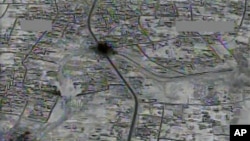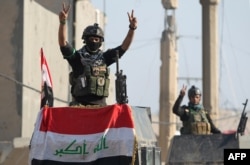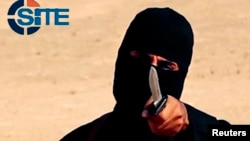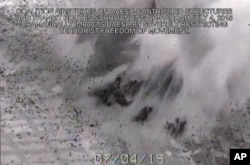An Islamic State judge is among the latest top jihadists to be killed in targeted coalition airstrikes that are seen as beginning to take a toll on the leadership ranks of the terrorist army.
U.S. officials vow 2016 will see many more strikes aimed at degrading the militant group's command and control structure and especially of its mid-level battlefield leadership.
U.S. commando raids designed to throw the group’s leadership off balance are also more likely.
The targeted airstrikes appear to be alarming the group — that is if the latest IS propaganda video is anything to go by, analysts say.
A gruesome ten-minute execution-style video released at the weekend, featuring five men from the city of Raqqa “confessing” under duress to having helped pinpoint locations and foreign jihadist fighters for bombing runs, suggests that airstrikes are figuring prominently in the minds of IS propagandists.
None of the men from Raqqa — all were filmed being shot dead at point-blank range — admitted in their forced confessions to having spied for any particular country, although the British-accented IS narrator says on the video they were working for British intelligence.
That allegation is dismissed by British authorities. And media activists with Raqqa is being slaughtered silently say the men were linked with their anti-IS network, which documents IS atrocities in the Syrian province.
Afzal Ashraf, an analyst with the Royal United Services Institute, a London-based think tank, says it is “doubtful that the men were members of a British spy cell.”
Frequent airstrikes
Whatever the truth about the murdered men, coalition airstrikes targeting IS leaders and battlefield commanders and modeled have become more frequent in recent weeks.
Last week, a Pentagon spokesman said 10 Islamic State leaders had been killed since early December, including individuals linked to the planning of the November terror attacks in Paris that left 130 dead.
Colonel Steve Warren, a spokesman for the U.S.-led military campaign against Islamic State, told reporters that the leadership deaths were affecting IS on the battlefield.
He attributed several successes of anti-IS fighters on the ground in recent weeks, including the retaking of the Iraqi city of Ramadi, to “the fact that the organization is losing its leadership.”
The latest targeted strike came Saturday on the Iraqi town of Tel Afar — an attack that killed Sharia Court judge Hisham Hussein Shakhbalar al-Afri and well as the IS security chief in the town, Taha Muhammad Nur Qazzan, according to Iraqi security sources.
They say a missile launched from a drone struck a convoy carrying the judge, killing him and Tel Afar’s security chief along with their 11 guards.
Other top figures from the group killed recently include Abdul Qader Hakim, who was slain in the Iraqi city of Mosul on December 24 and, in Syria on the same day, Charaffe al Mouadan. U.S. and European officials say both men were linked to the Paris attacks and were helping to plan other terrorist assaults in Europe.
Western governments appear keen to strike back quickly at IS planners responsible for the killing of their citizens, if for no other reason than to reassure their own publics.
Last November, British IS militant Mohammed Emwazi, who was dubbed by the press as “Jihadi John” and who appeared in several beheading videos, was believed to have been killed in a British drone strike in Syria. In August a British drone strike killed Reyaad Khan, a 21-year-old from Cardiff in Wales. In the same month, Junaid Hussain, a 21-year-old hacker-turned-jihadist from Birmingham in Britain, who ran an IS information and recruitment arm from Syria, was killed in a U.S. drone strike near Raqqa.
Granular intelligence
Targeted airstrikes require so-called granular intelligence, collected from phone-call intercepts and the monitoring of emails and text messages, information supplied from the ground either from drone and satellite surveillance, and human intelligence offered by spotters and spies.
“It’s not as easy as looking at an iPhone video of a convoy and then immediately striking,” General Martin Dempsey, who stepped down in September as the chairman of the U.S. Joint Chiefs of Staff, once cautioned a Senate panel.
With targeted strikes mounting, IS appears ever more concerned about spies helping to direct the bombing runs or spotting possible jihadists to strike. In the IS propaganda video released Sunday, one of the detained men, Obay Mohammed Abdul Ghani, a 26-year-old, claimed under duress that he was asked to film the tags of a specific car to pinpoint its location so it could be bombed.
In his forced confession, he said he was asked also for a map of the Islamic court building in Raqqa so that it could be bombed - and told to secure the computer IP address for an Australian member of IS so his location could be pinpointed.
In another forced confession a detainee says he was sent photographs of British IS fighters and asked to pinpoint their locations so they could be attacked.
IS appears to have become increasingly concerned about its vulnerability to airstrikes in Syria. In Raqqa the group has evacuated landmark buildings or thinned out the number of fighters occupying them,and more IS members are showing signs of being security conscious by wearing ski masks. Also, more fighters are being housed among the civilian population, according to anti-IS activists.












